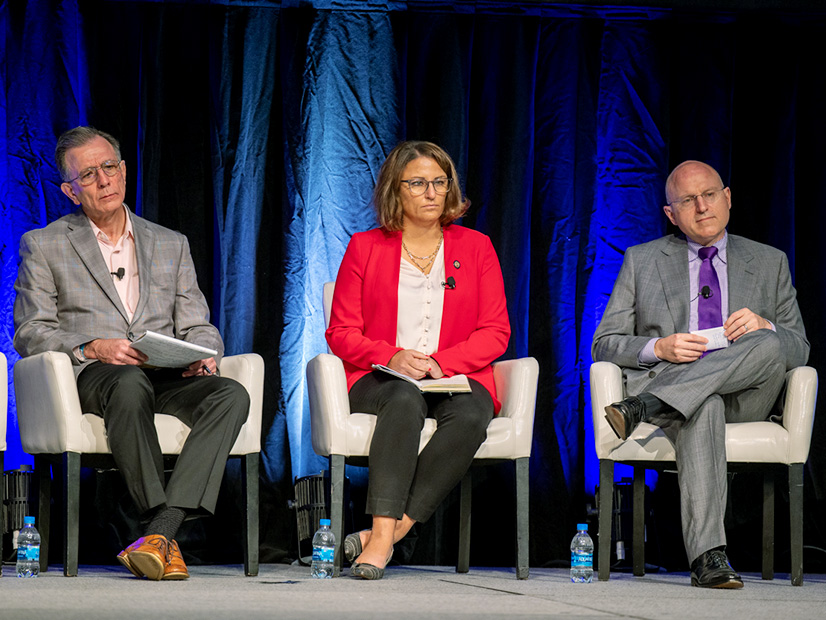
Construction of the New Jersey Wind Port on the Delaware River in Lower Alloways Creek is about to get underway, according to Tim Sullivan, CEO of the New Jersey Economic Development Authority.
Gov. Phil Murphy “signed a budget this year with $200 million cash for that project, so we will start construction on it within a matter of weeks,” Sullivan said Wednesday during the Business Network for Offshore Wind’s International Partnering Forum (IPF).
The new wind port, he said, represents an opportunity for the state to host multiple manufacturers and developers and “support the marshalling for projects outside New Jersey.”
Sullivan spoke during an IPF session moderated by RTO Insider Editor Rich Heidorn Jr. on how much offshore wind power might be needed to achieve state and federal clean energy goals.
Here are some highlights from the session.
More Wind
In Massachusetts, where a net-zero goal for 2050 is part of state law, with a 50% reduction of emissions required by 2030, 15 GW of offshore wind will be needed by 2050, said Judy Chang, undersecretary of energy for the Executive Office of Energy and Environmental Affairs.
To reach 15 GW, Massachusetts is focusing on developing port infrastructure, growing the supply chain and developing workforce opportunities, she said. The state is in an open bidding process now that will double the state’s procurements for a total of 3.2 GW.
Looking at all New England states, Chang said, the region will need about 30 GW by 2050.
New York has a much bigger appetite than its current 9-GW goal for 2035, according to Doreen Harris, president and CEO of the New York State Energy Research and Development Authority (NYSERDA).

“When I think about [9 GW] of offshore wind for New York, I see that as a floor, not a ceiling,” she said.
The state is about halfway to reaching its goal with five projects under development. A comprehensive study of offshore wind potential in the Great Lakes is also underway by NYSERDA. The study will help the state determine whether it should move forward with offshore wind procurements in Lake Ontario and Lake Erie. (See Smaller Turbines, Custom Vessels Define Future of Great Lakes OSW.)
Procurements
A growing interest in renewable energy and environmentally friendly operations by companies could bring a change in how offshore wind energy is purchased.
While the U.S. offshore wind industry is growing on a foundation of state procurements, private power purchase agreements, like those that took off in the solar space, may come as well, according to Stephen Moret, president and CEO of the Virginia Economic Development Partnership.
“It’s only natural that we would see [PPAs] develop in offshore wind, particularly for diversification, but also because there’s a limited amount of renewables, even though it’s growing very quickly,” he said.
In some places, he added, there is more demand than supply for renewable power. That imbalance is going to drive companies to look for direct engagement with offshore wind, he said.
Chang agreed, saying that businesses, private entities or municipalities will begin to act on the availability of choice in clean energy and contract on their own with offshore wind.
All renewables, she added, would benefit from a “significant transformation” of the wholesale electricity market.
“The idea is to have a centralized, wholesale-level clean attributes market so that all clean resources can participate, and the states and the utilities as well as independent entities, businesses and municipalities can be the buyers of those resources,” she said.
Massachusetts representatives, she added, are working with other states, ISO-NE and FERC to envision a clean capacity market and roll it out “in the not-too-distant-future.”
Transmission
The desire to move quickly to invest in and build out offshore wind in the U.S. creates a conundrum, Harris said.
Transmission investments need to move in parallel with generation investments, according to Harris.
“We cannot and will not wait years and years for an optimized transmission grid to be ready for those projects,” she said. “The projects should be built in a way that can accommodate a network of the future.”
That requires a “huge investment,” she added, noting that funding from the federal infrastructure bill could facilitate the investment scale needed for states to achieve their offshore wind goals.
Chang said states are at the beginning of a journey to understanding how to cost-effectively upgrade onshore transmission to interconnect offshore wind projects.
“We are still in a learning process,” she said. “I think we need to be better at coordinating the procurement process and our interconnection process with ISO-NE.”